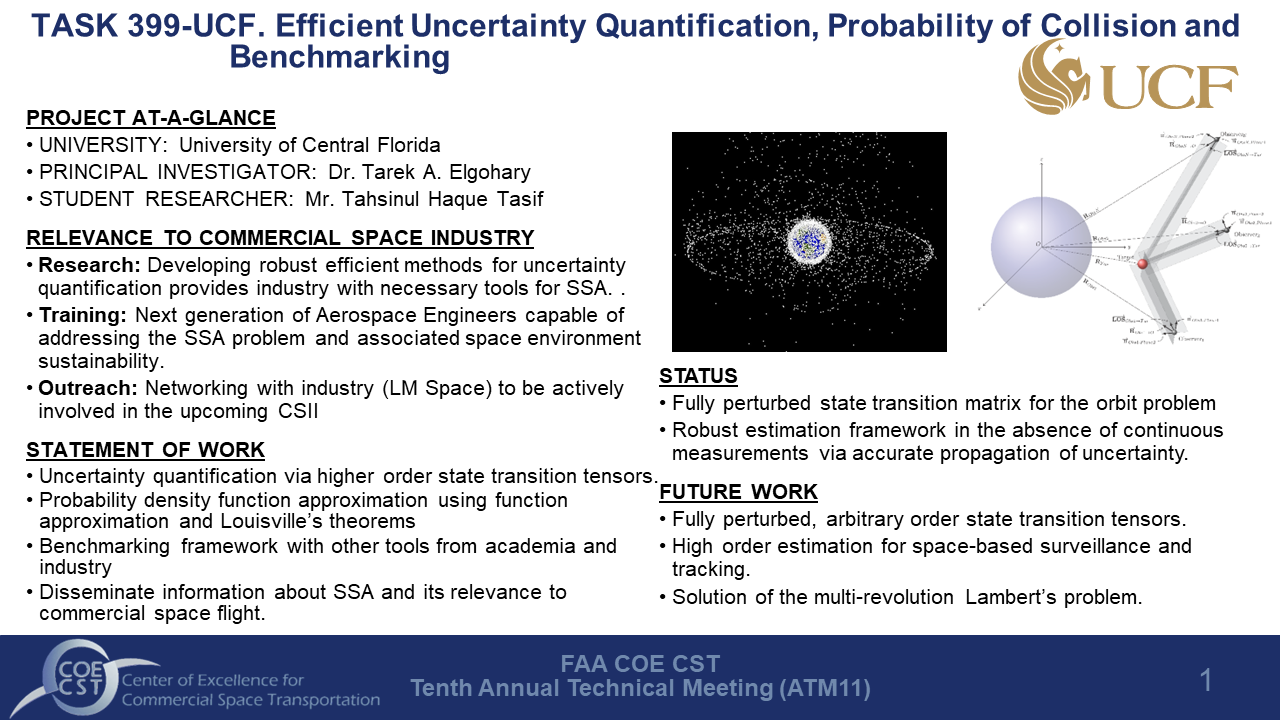399. Novel Techniques for Efficient Uncertainty Quantification, Probability of Collision and Benchmarking in Space
Team
| Name | Role | Primary |
|---|---|---|
| Tarek Elgohary | PI | ● |
| Ken Davidian | Tech Monitor | ● |
| Heliana Forero | Fiscal Admin | ● |
| Nagy Youssef | Fiscal Admin | ● |
| Yeliza Burleson | Contract Admin | ● |
Research Area
1.0 Space Traffic Management & Spaceport Operations
Project Description
As the number of current resident space objects (RSOs) is bound to increase due to further
fragmentation and debris collisions (Kessler Syndrome, [1]), an important question in Space
Situational Awareness (SSA) is: How to rigorously quantify uncertainty in orbit propagation
problems and accurately compute the probability of collision between RSOs? The locations and velocities of tracked RSOs are not known deterministically. Measurements errors, lower fidelity dynamics and sparsity of measurements are some of the contributing factors in the uncertainty surrounding RSOs. In order to compute the probability of collision, these uncertainties have to be propagated forward to the time of a potential collision. This operation is particularly challenging at the bounds of the prescribed uncertainty (lower probability regions) as it requires a very highfidelity uncertainty model. The proposed project develops a new method for efficiently propagating uncertainty for the orbit problem with both state and parametric uncertainties. By using global/local function approximation techniques and inverse-free nonlinear algebraic equations (NAEs) solvers, the proposed approach can accurately approximate the lower probability region of the probability density function (PDF) and simplifies all probability of collision calculations to integration/summation operations. Additionally, the new algorithm will be integrated into a benchmarking tool for testing/validating classical and newer algorithms for SSA problems.
Project Outcomes
This project will be achieved by a series of tasks sequenced to evaluate the proposed collocationmethods while integrating them into SSA algorithms. Keeping this in mind, we will start firstly by exploring basis functions such as RBFs, Moving Least Squares with different nodal distributions, e.g. uniform, cosine and Smolyak. Insights will be found regarding which basis function can give the best computational accuracy. Following that, Jacobian inverse-free NAEs solvers will be integrated into the algorithm to improve computational efficiency. Various benchmark problem will be evaluated to ensure the accurate quantification of uncertainty as well as the smooth integration with the proposed algorithms. Adaptive methods for the nodal distribution and domains will be implemented to optimize the developed algorithms to reduce the computation cost and mitigate the curse of dimensionality. Finally, the benchmarking tool will be developed to integrate the newly developed algorithms as well as classical approaches for uncertainty quantification, conjunction analysis and probability of collision calculations.
Summary of Output
Sustainability of the space environment to support terrestrial life is at the core of the US
National Space Policy [2]. In preserving the space environment, the document explicitly states, “Develop, maintain, and use space situational awareness (SSA) information from commercial, civil, and national security sources to detect, identify, and attribute actions in space that are contrary to responsible use and the long-term sustainability of the space environment”. The accurate quantification of uncertainty is key in SSA activities. Recent insights obtained from propagation of initial state error probability distributions for space situational awareness applications enable significant advances in uncertainty quantification algorithms [3, 4]. The proposed approach places an adaptive set of points on surfaces of know probability distribution to be propagated through the nonlinear dynamics and directly generate the nonlinearly distorted, non-Gaussian probability distribution at the time of interest. The method is applicable to both conservative and non-conservative systems for which a parametric description allows nonconservative effects to be included. The state space is augmented by the set of uncertain parameters in the perturbing force model, e.g. drag coefficient, and/or state measurement noise. These uncertain parameters are assumed constant, but unknown, and therefore satisfy trivial differential equations (their time derivative is zero), leading to an augmented space of an initial value problem with the state and uncertain parameters satisfying a joint probability density function. In this augmented space, points on the deterministic surfaces of constant probability in the low probability 1 Assistant Professor, Mechanical and Aerospace Engineering, University of Central Florida regions can be assigned. These points of known probability density can be propagated through time via the system dynamics. This essentially leads to an analytical representation of the probability density function (PDF) at the time of interest. Consequently, probabilistic analyses reduce to operations of summation/integration on simple interpolation functions. This approach describes the low probability density region of the PDF much more accurately than is feasible via Monte Carlo, Gaussian Mixture Models (GMMs) or Polynomial Chaos Expansions (PCEs), [5-10], due to slow convergence and the associated high computational cost which is known as the curse of dimensionality.
Quad Chart
